中国饮食文化英文介绍
- 格式:doc
- 大小:59.50 KB
- 文档页数:29
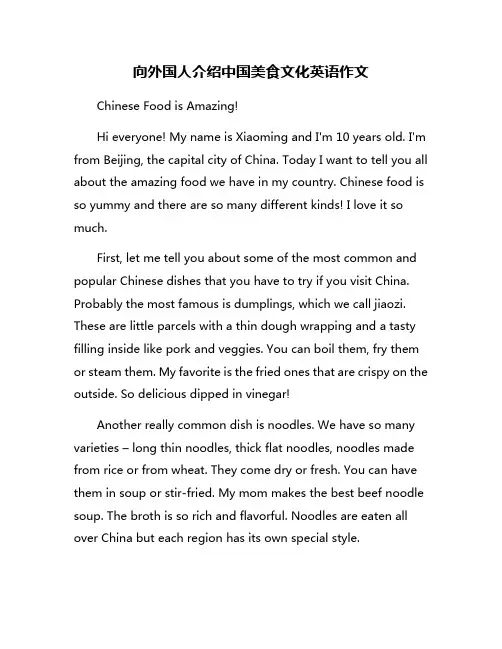
向外国人介绍中国美食文化英语作文Chinese Food is Amazing!Hi everyone! My name is Xiaoming and I'm 10 years old. I'm from Beijing, the capital city of China. Today I want to tell you all about the amazing food we have in my country. Chinese food is so yummy and there are so many different kinds! I love it so much.First, let me tell you about some of the most common and popular Chinese dishes that you have to try if you visit China. Probably the most famous is dumplings, which we call jiaozi. These are little parcels with a thin dough wrapping and a tasty filling inside like pork and veggies. You can boil them, fry them or steam them. My favorite is the fried ones that are crispy on the outside. So delicious dipped in vinegar!Another really common dish is noodles. We have so many varieties – long thin noodles, thick flat noodles, noodles made from rice or from wheat. They come dry or fresh. You can have them in soup or stir-fried. My mom makes the best beef noodle soup. The broth is so rich and flavorful. Noodles are eaten all over China but each region has its own special style.Then we have rice dishes like yangzhou fried rice. This has eggs, little pieces of meat or shrimp, peas, carrots and more fried together with rice. It's really tasty, especially with some soy sauce drizzled over the top. A lot of families will have a big plate of fried rice as a main dish for lunch or dinner.Those are some of the most common main dishes, but there are endless varieties of dim sum for snacks or small plates too. Dim sum is like little bite-sized dishes that you share with family or friends. Things like steamed shrimp dumplings (har gow), barbecue pork buns (cha siu bao), rice noodle rolls (cheung fun) and more. Going out for dim sum on the weekend is a really fun family tradition.Chinese food isn't just about the dishes themselves - how you eat is part of the culture too. We eat with chopsticks instead of forks. Using chopsticks takes practice but it's really satisfying once you get the hang of it. You'll feel like a pro!And meals are very social affairs. All the dishes get shared among everyone at the table. You take a little bit from each plate onto your bowl of rice. It's a way to taste many different flavors and dishes. My grandma always tells me that sharing food brings the family closer together.There are also lots of different cooking techniques used in Chinese cuisine like stir-frying, steaming, braising and more. Chinese chefs are really skilled and their knives skills for chopping vegetables are amazing to watch. The food is so beautifully presented too with lovely garnishes and carvings.Chinese food has a really long history going back thousands of years. Over time, each region of China developed its own unique cuisine and specialties based on the local climate, ingredients and traditions. That's why you'll find such a variety across the huge country.For example, in Sichuan province the food is famous for being really spicy with dishes loaded up with chilies and Sichuan peppercorns. But in Guangdong (Cantonese) cuisine, the flavors are more mild and subtle. A lot of Cantonese dishes get steamed or stir-fried to keep the fresh tastes of the ingredients.Beijing where I'm from has its own style too. We love meat dishes and dumplings of course. But we also have lots of amazing snack street foods like jianbing (crispy crepe wraps), tanghulu (candied fruit on a skewer) and bingtanghulu (candied haws on a stick). I'll take you to try some if you visit!As well as regional cuisines, there are also special foods for different festivals and celebrations throughout the year. Likeduring Chinese New Year, every family makes jiaozi (dumplings) because they're shaped like little lucky money pouches. We put different lucky fillings inside like diced vegetables to symbolize wealth.For the Moon Festival in autumn, we eat mooncakes—round pastries stuffed with sweet fillings like lotus seed paste or egg yolks to look like the full moon. They're so nice with a cup of hot tea!Food is just such an important part of Chinese culture and family life. I have so many happy memories of helping my grandma cook dumplings, or my whole extended family getting together to make niangao (sweet glutinous rice cake) for New Year's. The smells and tastes are tied to all our big occasions and traditions.Outside of the home, you can find amazing restaurants and street food everywhere in China too. From hole-in-the-wall noodle joints to big fancy dining halls, there's incredible food at every level. The variety is just endless!Whew, I could honestly talk about Chinese cuisine all day. But I'll stop here for now. I hope you've learned a little bit about how amazing and diverse the food is in my country. It's a huge part of our culture and traditions going back many centuries.If you ever visit China, I'll take you to all my favorite restaurants, street stalls and markets. You have to experience the real deal! Just be ready because we'll eat A LOT. That's the proper Chinese way - to eat until you're totally stuffed. Food is life for us! Let me know when you're coming to visit. I'll save you a big plate!。
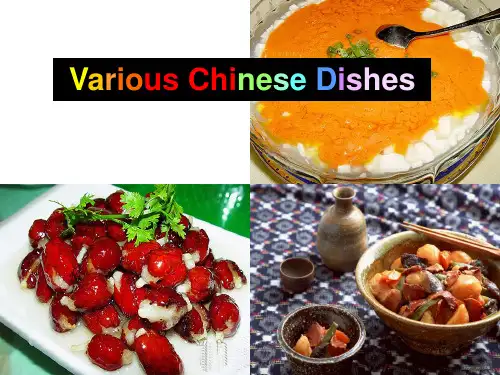
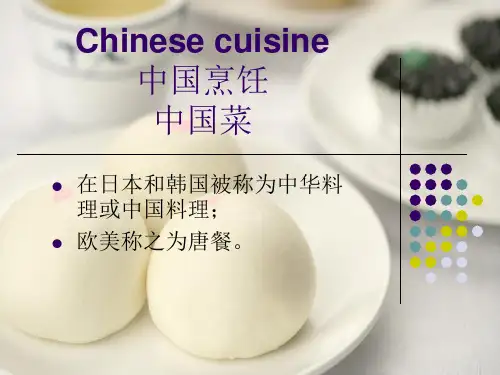
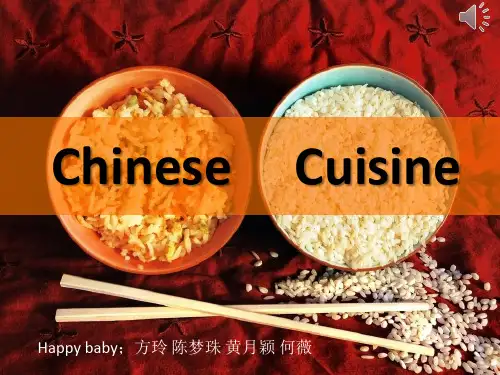
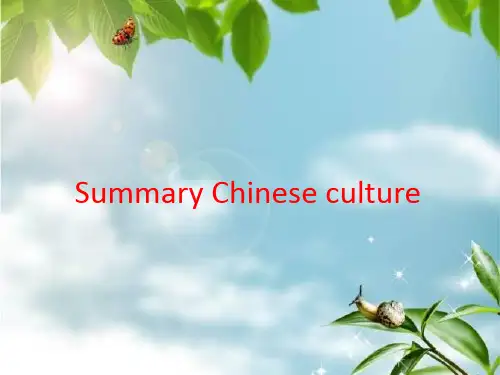
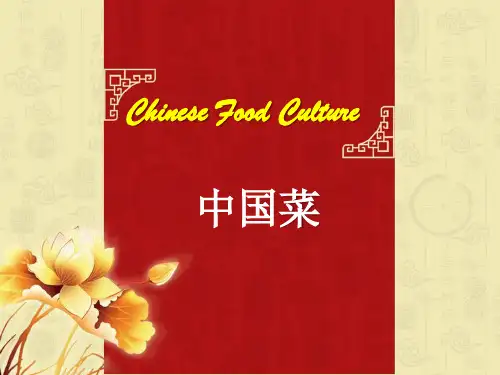
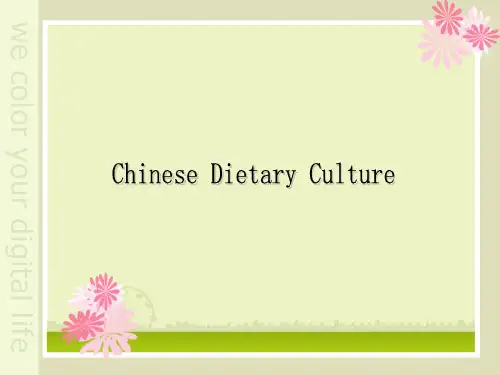
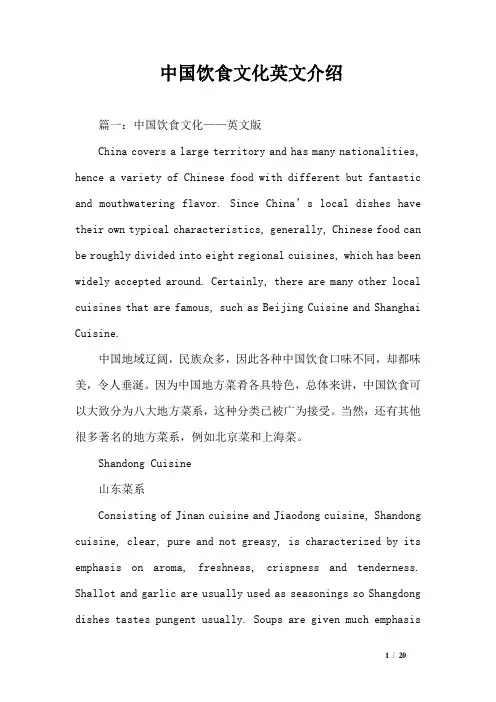
中国饮食文化英文介绍篇一:中国饮食文化——英文版China covers a large territory and has many nationalities, hence a variety of Chinese food with different but fantastic and mouthwatering flavor. Since China’s local dishes have their own typical characteristics, generally, Chinese food can be roughly divided into eight regional cuisines, which has been widely accepted around. Certainly, there are many other local cuisines that are famous, such as Beijing Cuisine and Shanghai Cuisine.中国地域辽阔,民族众多,因此各种中国饮食口味不同,却都味美,令人垂涎。
因为中国地方菜肴各具特色,总体来讲,中国饮食可以大致分为八大地方菜系,这种分类已被广为接受。
当然,还有其他很多著名的地方菜系,例如北京菜和上海菜。
Shandong Cuisine山东菜系Consisting of Jinan cuisine and Jiaodong cuisine, Shandong cuisine, clear, pure and not greasy, is characterized by its emphasis on aroma, freshness, crispness and tenderness. Shallot and garlic are usually used as seasonings so Shangdong dishes tastes pungent usually. Soups are given much emphasisin Shangdong dishes. Thin soup features clear and fresh while creamy soup looks thick and tastes strong. Jinan cuisine is adept at deep-frying, grilling, frying and stir-frying while Jiaodong division is famous for cooking seafood with fresh and light taste.山东菜系,由济南菜系和胶东菜系组成,清淡,不油腻,以其香,鲜,酥,软而闻名。
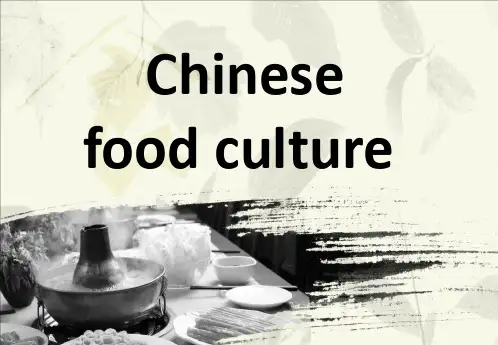

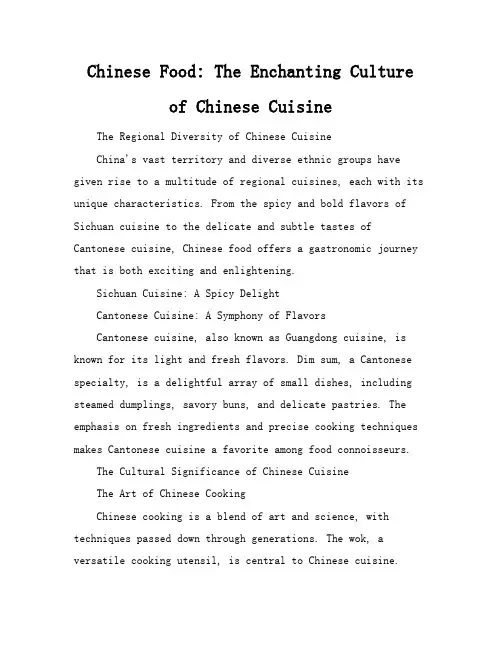
Chinese Food: The Enchanting Cultureof Chinese CuisineThe Regional Diversity of Chinese CuisineChina's vast territory and diverse ethnic groups have given rise to a multitude of regional cuisines, each with its unique characteristics. From the spicy and bold flavors of Sichuan cuisine to the delicate and subtle tastes of Cantonese cuisine, Chinese food offers a gastronomic journey that is both exciting and enlightening.Sichuan Cuisine: A Spicy DelightCantonese Cuisine: A Symphony of FlavorsCantonese cuisine, also known as Guangdong cuisine, is known for its light and fresh flavors. Dim sum, a Cantonese specialty, is a delightful array of small dishes, including steamed dumplings, savory buns, and delicate pastries. The emphasis on fresh ingredients and precise cooking techniques makes Cantonese cuisine a favorite among food connoisseurs.The Cultural Significance of Chinese CuisineThe Art of Chinese CookingChinese cooking is a blend of art and science, with techniques passed down through generations. The wok, a versatile cooking utensil, is central to Chinese cuisine.Stirfrying, a quick and highheat cooking method, is used to create dishes like Beef and Broccoli and Kung Pao Chicken, ensuring that ingredients remain fresh and vibrant.In conclusion, Chinese cuisine is a treasure trove of flavors, traditions, and stories. By exploring the diverse regional cuisines and understanding the cultural significance behind each dish, one can gain a deeper appreciation for the enchanting culture of Chinese food.The Philosophy Behind Chinese Culinary ArtsThe Importance of Seasonality and FreshnessChinese culinary traditions place a strong emphasis on the use of seasonal ingredients. The belief is that food should be consumed when it is at its peak of freshness and flavor. This respect for nature's rhythm ensures that diners enjoy the best that each season has to offer. From spring's tender bamboo shoots to winter's hearty root vegetables, the changing of the seasons is celebrated on the Chinese dining table.The Role of Tea in Chinese CultureThe Art of Table Manners and EtiquetteThe Future of Chinese CuisineAs Chinese cuisine continues to captivate the world, it is evolving while maintaining its traditional roots. Young chefs are experimenting with fusion styles, blendingtraditional Chinese flavors with international influences.This innovation is breathing new life into classic dishes, making Chinese cuisine more accessible and appealing to a global audience.The Spiritual Connection of Food and FestivalsIn the tapestry of Chinese culture, food plays a pivotal role during festivals and holidays, symbolizing wishes, traditions, and spiritual beliefs. Each festival brings withit a array of special dishes, each carrying its own meaning and significance.The Lunar New Year, or Spring Festival, is perhaps the most celebrated of all. Families gather for a grand feast known as the "Reunion Dinner," where dishes like fish (symbolizing surplus and prosperity), dumplings (shaped like ancient Chinese money and representing wealth), and nian gao (a sweet sticky rice cake signifying growth and progress) are served. These foods are not only delicious but are also eaten with the hope of bringing good fortune for the year ahead.The Art of Presentation and AestheticsChinese cuisine is not only about taste but also about presentation. The arrangement of dishes on a table is an art form in itself, with an emphasis on color, shape, and balance. The goal is to create a visual feast that excites the eyes before the food even touches the lips. This aestheticapproach is evident in the intricate carvings of vegetables and fruits used as garnishes, and in the careful placement of ingredients to form patterns and pictures on the plate.The Legacy of Chinese Culinary TechniquesThe legacy of Chinese cooking techniques is a testament to the ingenuity and resourcefulness of its people. Methods such as red cooking (braising in soy sauce), white cooking (simmering in water or stock), and the delicate art of dim sum making are passed down through generations. These techniques not only enhance the flavors and textures of the ingredients but also preserve the nutritional value of the food, reflecting the Chinese philosophy of health and wellness through diet.The Global Reach of Chinese CuisineIn essence, Chinese cuisine is a living history book, each page filled with stories of tradition, innovation, and the joy of sharing. It is a journey that invites all to partake, a celebration of flavors and cultures that continues to inspire and delight palates worldwide.。
介绍中国美食的高考英语作文English: Chinese cuisine is renowned worldwide for its rich flavors, diverse ingredients, and exquisite cooking techniques. From the spicy flavors of Sichuan cuisine to the delicate dim sum of Cantonese cuisine, China offers a vast array of dishes that appeal to different taste preferences. Some popular Chinese dishes include Peking duck, Kung Pao chicken, hot pot, and dumplings. Additionally, Chinese cuisine emphasizes the balance of flavors, textures, and colors in each dish, creating a harmonious dining experience. In recent years, Chinese cuisine has gained popularity globally, with more and more people enjoying the authentic flavors and unique ingredients that Chinese cooking has to offer.中文翻译: 中国美食以其浓郁的口味、多样的食材和精致的烹饪技巧而闻名于世。
从四川菜的辛辣味道到广东菜的精致点心,中国提供了各种各样的菜肴,以迎合不同的口味偏好。
一些流行的中国菜包括北京烤鸭、宫保鸡丁、火锅和饺子。
各国饮食文化介绍作文英文In China, food is not just about satisfying hunger,it's a way of life. The Chinese cuisine is diverse and rich in flavors, with a focus on fresh ingredients and a balance of colors and textures. From the spicy Sichuan cuisine to the delicate flavors of Cantonese dishes, Chinese food reflects the country's vast and varied landscape.In Italy, food is a celebration of tradition and family. Italian cuisine is known for its simple yet flavorful dishes, using fresh and high-quality ingredients such as tomatoes, olive oil, and cheese. From pasta to pizza,Italian food is all about bringing people together and enjoying good company with good food.In Japan, food is an art form. Japanese cuisine is characterized by its meticulous preparation and presentation, with an emphasis on seasonal ingredients and minimal seasoning to bring out the natural flavors of the food. From sushi to tempura, Japanese food is a reflectionof the country's respect for nature and tradition.In India, food is a sensory explosion. Indian cuisine is known for its bold and complex flavors, with a wide variety of spices and herbs used to create dishes that are both aromatic and flavorful. From the rich and creamy curries of the north to the spicy and tangy dishes of the south, Indian food is a reflection of the country's diverse culture and history.In Mexico, food is a fiesta for the taste buds. Mexican cuisine is a blend of indigenous and Spanish influences, with a focus on fresh ingredients such as corn, beans, and chili peppers. From tacos to tamales, Mexican food is all about bold flavors and vibrant colors, reflecting the country's lively and colorful culture.。
关于向西方人介绍中国的餐桌文化的英语作文English:Chinese dining culture is rich in tradition and etiquette, reflecting the long history and diverse regional influences of the country. A typical Chinese meal consists of a variety of dishes shared family-style, where each person takes a small portion of different dishes onto their own plate. It is common for hosts to order more dishes than the number of guests to show generosity and hospitality. Table manners are also important in Chinese dining culture, such as using chopsticks properly, not rest them upright in a bowl, and not flipping over whole fish as it symbolizes bad luck. Food symbolism is also prominent in Chinese dining culture, where certain dishes are served during special occasions or festivals to bring good luck and prosperity. Overall, Chinese dining culture is a reflection of the importance of family, respect, and harmony in Chinese society.Translated content:中国的餐桌文化传统悠久、礼节丰富,反映了中国悠久的历史和多元的地区影响。
中国传统美食英文手写作文英文:Chinese traditional cuisine is known for its rich flavors and unique cooking techniques. As a Chinese person, I have grown up eating a variety of traditional dishes that have been passed down from generation to generation. Some of my favorite dishes include dumplings, hot pot, and Peking duck.Dumplings, also known as jiaozi, are a staple in Chinese cuisine. They are made by wrapping a filling of meat, vegetables, or both in a thin layer of dough and then steaming or boiling them. Dumplings can be eaten as a snack or as a meal and are often served during Chinese New Year celebrations.Hot pot, or huoguo, is another popular dish in China.It consists of a pot of simmering broth in which diners cook various meats, vegetables, and noodles. The cookedfood is then dipped in a sauce before being eaten. Hot pot is a great way to bring people together as it is often enjoyed in a communal setting.Peking duck is a famous dish from Beijing that has become popular all over the world. It is made by roasting a whole duck until the skin is crispy and then serving it with thin pancakes, scallions, and a sweet bean sauce. Peking duck is often served at special occasions or as a luxurious meal.中文:中国传统美食以其丰富的口味和独特的烹饪技巧而闻名。
中国传统餐饮英文作文高中英文:Traditional Chinese cuisine is not only delicious, but it also reflects the rich cultural heritage of China. From Peking duck to dim sum, Chinese food has a wide variety of flavors and cooking techniques that have been passed down for generations.One of my favorite traditional Chinese dishes is hot pot. It's a popular meal in China, especially during the winter months. The hot pot is a communal meal where a pot of simmering broth is placed in the center of the table, and everyone adds their choice of meats, vegetables, and noodles to cook in the broth. It's a fun and interactive dining experience that brings people together.Another classic Chinese dish that I love is Mapo tofu. This spicy and flavorful dish originated from the Sichuan province and is made with tofu, minced meat, and fermentedblack beans. The combination of numbing Sichuan peppercorns and spicy chili peppers creates a unique and addictiveflavor that I can't get enough of.中文:中国传统餐饮不仅美味,而且反映了中国丰富的文化遗产。
中国饮食文化英文介绍各位读友大家好,此文档由网络收集而来,欢迎您下载,谢谢篇一:中国饮食文化——英文版China covers a large territory and has many nationalities, hence a variety of Chinese food with different but fantastic and mouthwatering flavor. Since China’s local dishes have their own typical characteristics, generally, Chinese food can be roughly divided into eight regional cuisines, which has been widely accepted around. Certainly, there are many other local cuisines that are famous, such as Beijing Cuisine and Shanghai Cuisine.中国地域辽阔,民族众多,因此各种中国饮食口味不同,却都味美,令人垂涎。
因为中国地方菜肴各具特色,总体来讲,中国饮食可以大致分为八大地方菜系,这种分类已被广为接受。
当然,还有其他很多著名的地方菜系,例如北京菜和上海菜。
Shandong Cuisine山东菜系Consisting of Jinan cuisine and Jiaodong cuisine, Shandong cuisine, clear, pure and not greasy, is characterized by its emphasis on aroma, freshness, crispness and tenderness. Shallot and garlic are usually used as seasonings so Shangdong dishes tastes pungent usually. Soups are given much emphasis in Shangdong dishes. Thin soup features clear and fresh while creamy soup looks thick and tastes strong. Jinan cuisine is adept at deep-frying, grilling, frying and stir-frying while Jiaodong division is famous for cooking seafood with fresh and light taste.山东菜系,由济南菜系和胶东菜系组成,清淡,不油腻,以其香,鲜,酥,软而闻名。
因为使用青葱和大蒜做为调料,山东菜系通常很辣。
山东菜系注重汤品。
清汤清澈新鲜,而油汤外观厚重,味道浓重。
济南菜系擅长炸,烤,煎,炒,而胶东菜系则以其烹饪海鲜的鲜淡而闻名。
Shandong is the birthplace of many famous ancient scholars such as Confucious and Mencius. And much of Shandong cuisine’s history is as old as Confucious himself, making it the oldest existing major cui sine in China. But don’t expect to gain more wisdom from a fortune cookie at a Shandong restaurant in the West since fortune cookies aren’t even indigenous to China.山东是许多著名学者的故乡,例如孔夫子和孟子。
许多山东菜的历史和孔夫子一样悠久,使得山东菜系成为中国现存的最古老的主要菜系之一。
但是不要期望在西方国家的山东菜馆里从签饼(中国餐馆的折叠形小饼,内藏有预测运气话语的纸条)获得更多的好运气,因为签饼在中国也不是本土的。
Shandong is a large peninsula surrounded by the sea to the East and the Yellow River meandering through the center. As a result, seafood is a major component of Shandong cuisine. Shandong’s most famous di sh is the Sweat and Sour Carp. A truly authentic Sweet and Sour Carp must come from the Yellow River. But with the current amount of pollution in the Yellow River, you would be better off if the carp was from elsewhere. Shandong dishes are mainly quick-fried, roasted, stir-fried or deep-fried. The dishes are mainly clear, fresh and fatty, perfect with Shandong’s own famous beer, Qingdao Beer山东是个巨大的被向东流去的大海环绕的半岛,黄河曲折的流经其中部。
因此海鲜是山东菜系的主要构成。
山东最著名的菜肴是糖醋鲤鱼。
正宗的糖醋鲤鱼必须打捞自黄河。
但是因为现在黄河的众多污染,其他地方的鲤鱼更好一些。
山东菜主要是速炸,烧烤,炒或深炸。
菜肴清新肥美,搭配山东本地的著名啤酒——青岛啤酒就完美了。
Sichuan Cuisine四川菜系Sichuan Cuisine, known often in the West as Szechuan Cuisine, is one of the most famous Chinese cuisines in the world. Characterized by its spicy and pungent flavor, Sichuan cuisine, prolific of tastes, emphasizes on the use of chili. Pepper and prickly ash also never fail to accompany, producing typical exciting tastes. Besides, garlic, ginger and fermented soybean are also used in the cooking process. Wild vegetables and animals are usually chosen as ingredients, while frying, frying without oil, pickling and braising are applied as basic cooking techniques. It cannot be said that one who does not experience Sichuan food ever reaches China.四川菜系,是世界上最著名的中国菜系之一。
四川菜系以其香辣而闻名,味道多变,着重使用红辣椒,搭配使用青椒和prickly ash,产生出经典的刺激的味道。
此外,大蒜,姜和豆豉也被应用于烹饪过程中。
野菜和野禽常被选用为原料,油炸,无油炸,腌制和文火炖煮是基本的烹饪技术。
没有品尝过四川菜的人不算来过中国。
If you eat Sichuan cuisine and find it too bland, then you are probably not eating authentic Sichuan cuisine. Chili peppers and prickly ash are used in many dishes, giving it a distinctively spicy taste, called ma in Chinese. It often leaves a slight numb sensation in the mouth. However, most peppers were brought to China from the Americas in the 18th century so you can thank global trade for much of Sichuan cuisine’s excellence. Sichuan hot pots are perhaps the most famous hotpots in the world, most notably the Yuan Yang (mandarin duck)Hotpot half spicy andhalf clear.如果你吃四川菜,发现它过于柔和,那么你可能吃的不是正宗的四川菜。
红绿辣椒被用在许多菜肴中,带来特别的辣味,在中国文字里叫麻,通常会在口中留下麻木的感觉。
然而,多数青椒是在18世纪从美国传入中国的,因此你应当为四川菜的精妙而感谢全球贸易。
四川火锅也许是世界上最出名的火锅,尤其是半辣半清的鸳鸯火锅。
Guangdong Cuisine广东菜系Cantonese food originates from Guangdong, the southernmost province in China. The majority of overseas Chinese people are from Guangdong (Canton)so Cantonese is perhaps the most widely available Chinese regional cuisine outside of China.广东菜源自于中国最南部的省份广东省。
大多数华侨来自广东,因此广东菜也许是国外最广泛的中国地方菜系。
Cantonese are known to have an adventurous palate, able to eat many different kinds of meats and vegetables. In fact, people in Northern China often say that Cantonese people will eat anything that flies except airplanes, anything that moves on the ground except trains, and anything that moves in the water except boats. This statement is far from the truth, but Cantonese food is easily one of the most diverse and richest cuisines in China. Many vegetables originate from other parts of the world. It doesn’t use much spice, bringing out the natural flavor of the vegetables and meats.广东人热衷于尝试用各种不同的肉类和蔬菜。